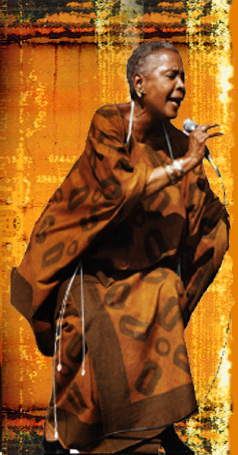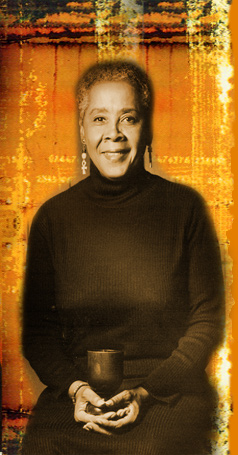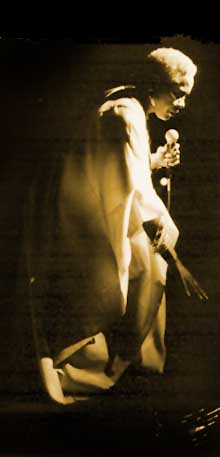CAMILLE YARBOROUGH / “Dream/Panic/Sonny Boy the Rip-Off Man/Little Sally the Super Sex Star”
This is a classic from deep back in the day. 1975. A high point of black power-oriented popular music. Popular! The music not only had a message, it was a message of critical consciousness, opposition to the status quo, a call to get up and do something about prevailing conditions. Onward. March. Struggle. Fight. Like that. But it was also street-oriented, i.e. it dealt with issues common among the working class and the unemployed in the ghettoes and inner cities of America.
There are no dreams of little white girls and little black boys holding hands and pledging allegiance. There’s a reason most youth have probably never heard this one. A complex reason. A reason that includes why many of us in our forties and fifties didn’t hear it. The reason is real: this is the music of movement and consciousness raising, not of status quo dreams and fantasies.

Camille Yarbrough is a musician/performance artist and writer whose 1975 album was critically acclaimed when initially released. The songs are all adapted from her touring one-woman program “Tales of an African American Griot.” In 1998 British DJ Fatboy Slim remixed “Take Your Praise” and produced “Praise You,” an international hit, which was also picked up for major commercials. Camille has a self-produced CD, Ancestor House, that is available from CD Baby. She has produced four, award-winning children’s books: Cornrows; Tamika and the Wisdom Rings; Shimmershine Queens; and The Little Tree Growing in the Shade. For more info on Camille, please go to her Ancestor House website.

The featured track, “Dream…,” is an interlocking trio of stories illustrating the underbelly of ghetto life in unsparing detail. Camille’s storytelling ability is unparalleled as she conjures up portraits of the negative in order to teach us the positive. Is there a difference here between what Camille does and gangsta rap? I believe so. Regardless of how real the scenarios are, one can never get the impression that Camille is glorifying or celebrating these demented characters, even as we are given a sensitive insider’s understanding of the characters’ conditions and consciousness.
I bet you listen more than once to this track. Bet you do. And bet you come away not only impressed with Camille griot abilities, but also fully aware that there’s nothing positive about these street folk who survive in hyena fashion by eating the flesh of others. Ultimately, even studying the results of downpression is uplifting when recited by a fully conscious African American griot.
—Kalamu ya Salaam
Well....
Well.... Baba, you say the reason most of us haven't heard this music before (and I haven't) is because "this is the music of movement and consciousness raising, not of status quo dreams and fantasies." I don't think it's that simple. I think the reason has more to do with the style of the presentation. Gil Scott-Heron (to name the first person that comes to mind) practically exemplifies "music of movement and consciousness raising," but he did his consciousness raising to the tune of memorable melodies and hit-worthy hooks. (Mostly. And when he did his poetry, he usually did it with a comedic and sarcastic tone, which makes it easy to listen to.) Sister Camille's track is more like extemporaneous poetry set to the tune of free jazz—not the easiest thing on the ears, I think you'd have to admit that. I dig the words she's saying and I appreciate what she's trying to do, but in order to actually like this record, I'd need a little something more to hold on to.
—Mtume ya Salaam
This entry was posted on Sunday, December 10th, 2006 at 1:23 am and is filed under Classic. You can follow any responses to this entry through the RSS 2.0 feed. You can leave a response, or trackback from your own site.
2 Responses to “CAMILLE YARBOROUGH / “Dream/Panic/Sonny Boy the Rip-Off Man/Little Sally the Super Sex Star””
December 10th, 2006 at 9:43 am
Yes, I understand and sympathize with both of your views. But Mtume raises an important view about audience acceptability or popularity of the musical approach used by Camille. Hers indeed is not as marketable as Gill-Scott. I’m not sure exactly what’s the problem, whether it’s the lyrics or the delivery of the lyrics or the music in the background or whether its the working together of lyrics and music. It would be interesting to know what role the musician played in the piece or Camille’s musical knowledge. It would be interesting to compare the work of Jayne Cortez, once married to Ornette Coleman, and her use of his band, side by side with Camille and her band. Still I can listen/live with Camille’s work much more than most of the rap lyrics and rhythms played daily on radio and in videos. Yes, Kalamu, I listened to it more than once. Some works need several listenings to tune our ears for true appreciation. Consciousness raising appeals to the mind, makes demands on the understanding. Rap rhythms make their appeal to the body. The latter is easier and less demanding. Not necessarily more better — Rudy
it’s the jazz
as soon as mtume said free jazz i knew what the deal is… in the early seventies, jazz was the music of the movement, much more so than r&b… free jazz was popular. pharoah sanders in particular. but bunches of others also, plus the more mainstream orientated musicians were also stretching out. i did not hear camille’s music as free jazz, but i understand what is being said about her. it is the sound. the sound of that era was oppositional. just like you noted how the beat of hip hop makes it easy to listen to today’s music. yes, free jazz forces you to think when you listen to it because it does away with the comfort (some would say, "crutch") of a constant beat. thanks rudy for your comments. it is an accurate accessment.
—Kalamu ya Salaam
Popularity, the Seventies and Blaxpoitation
OK, hold on. There’s popular and then there’s popular. By the standards of pop music (i.e., ‘popular’ music), free jazz was never popular. Hell, I don’t think free jazz was ever popular by any standard, unless you mean popular among certain segments of certain circles in certain places. I’m only guessing, but I would be very surprised if the best-selling free jazz album of all time topped 50,000 copies sold. In a country of hundreds of millions, that can’t be considered popular by any means.
Then there’s the issue of "the sound of the era" and it being an oppositional sound. If that’s true, how come there are so many enduring and *popular* classics of, say, 1975 or 1976? Think about your all-time favorite soul records or your all-time favorite reggae records. Chances are, they were cut sometime between 1971 and 1977. There is an awful lot of very popular, very tuneful and very classic music that came out of the era in question. And I’d hardly consider most of it ‘oppositional.’ (In sound, I mean. Not in subject matter.)
One last thing. Instead of comparing Camille’s record to modern-day radio rap (which, in my opinion, is a major stretch), how’s about comparing her to something more relevant. Like say, the endless parade of blaxpoitation soundtracks that often talked about the same subjects, but in an exploitative manner rather than a "consciousness-raising" one. In fact, you can probably find a bunch of records that came out the same year (1975) that would fit the bill. I’m just saying.
—Mtume ya Salaam
it ain’t news, most people just don’t know it
it takes a nation of millions to… mtume, you are so, so right in terms of defining "popular," but there’s so much more there than is apparent, there being the black power era. i promise you, over the next couple of months, we’re going to address some of these issues through the music, so for now, let me just drop two ideas for your consideration.
first: you are right that i should compare camille with blaxploitation soundtracks and not just with gangsta rap. one of my biases is i spent most of my twenties and thirties deeply involved in black power activity and there is no way i can erase those experiences. unavoidably, those experiences also become a personal measuring rod. part of my issue is that i see gangsta rap as exactly the same aesthetic as blaxploitation, both of which were commercially driven, hence, i compare and contrast them. some times it makes sense to everyone, other times it seems like i’m coming out of left field (and i am!). as you grow older and are faced with whatever comes next musically, i’m sure you will find yourself comparing the next thing to hip hop. it’s unavoidable. but back to me and my context.
foxy brown and cleopatra jones, neither one of them held a candle to the real badddd lady, i.e. angela davis. look at the look on those ladies. you see any resemblelance? it’s not coincidental. moreover, those blaxploitation chicks had nothing on your mother, who not only ran an independent school but also learned to shoot when our organization decided that women and men must be trained in weapons. that era was no joke. in this a here era of rampant anti-terriorism, i think it best i not say anymore about what badddd really means, except to say, blaxploitation was a covert and overt effort to wean the majority of black folk away from open, armed rebellion.
second: popularity. you are right, this music was popular with a specific segment, the segment that was going to get up and do something, the segment that was going to actively challenge the status quo, the segment that was going to run schools such as you went to; go head to head with the klan like some of the rallies you went to as a child; travel to cuba, nicarguaga, china, all over africa, actively supporting liberation movements like your parents did. this music was fuel for us to keep focused and stay strong while we faced down the beast. i know that much of the jazz of that era sounds "weird" and "unmelodic," not to mention no steady beat, but brother was it ever what we needed to keep on literally (war)-dancing in the streets. i’m not trying to convince you to like it, just want to make you aware of it, and aware of the meanings inherent in it, and the context out of which this type of music originated.
stay tuned. to be continued…
—Kalamu ya Salaam
Leave a Reply
| top |